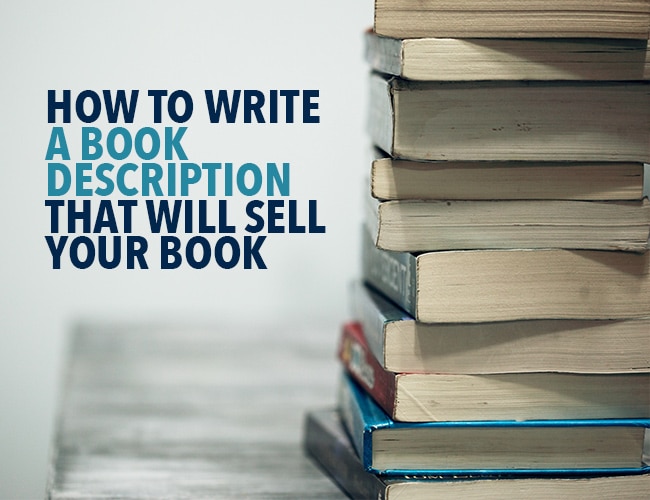What is the first thing you check on a book (after the cover art)? I would bet, whether you’re at the library, at a bookstore, or shopping online, it’s the book description. What does that mean for you as a writer? You need to know how to write a book description, preferably a great one.
Nothing sells a book like a well-written description.

I recently picked up a nonfiction book, which I don’t read many of, and almost put it right back down. But the description intrigued me. It got me to read the first couple pages, standing right there in the store. Then it got me to buy the book.
A book description is one of the most crucial elements to selling your book (if not the crucial element), and yet it’s often the hardest thing for writers to come up with.
As the creator of the story, authors don’t want to leave anything out. There’s a tendency to want to put every little element in the book in there. After all, you wouldn’t have written all those subplots if they weren’t important, right?
The thing is, the description isn’t a summary or a book report. It’s an ad.
Say it with me: The book description is an ad!
Start thinking of the description as a marketing tool now. And read on for a few other tips on how to write a book description.
How to Write a Book Description for Any Book
You should heed the following five tips regardless of whether you’ve written a nonfiction or fiction book.
1. Keep it short.
Somewhere between 150 and 250 words and no more than three paragraphs. You don’t want to bore people into putting the book down and the fewer words, the less likely you are to put in unnecessary plot points.
2. Write in third person.
It doesn’t matter if the book is written in first person. This isn’t the book itself, it’s an ad.
3. Don’t overdo the language.
You want simple, straightforward terms. No purple prose or verbose writing.
4. Write a hook.
Just like your book needs a hook at the beginning, so does your book description. No one’s going to keep reading the description, let alone the whole book, if the first line is as boring as dry toast. Plus, this is often the only thing an online shopper will see before they’re prompted to click to see more, and you want them to click.
5. Use keywords.
Emotional words, like chilling or passion, work well for both nonfiction and fiction book descriptions. You can Google power words to find some good ones. Don’t overdo it, though!
You’ll also want to consider what people might be Googling that would lead them to your book. This is especially true for nonfiction works.
How to Write a Book Description for Nonfiction
Nonfiction books have slightly different descriptions that fiction books. They often include bullet points to outline the book’s goals and procedures and they talk more about the author than the book itself. Here are some additional tips for how to write a book description for a nonfiction book:
1. Make it relevant.
Clarify why the reader should choose this book over others, what they’re going to get from the book, and how the book will give it to them.
2. Add your expertise.
Why are you the one to help the reader instead of the next person? Why should they take a journey through your memoir instead of someone else?
How to Write a Book Description for Fiction
Fiction descriptions are what we’re most familiar with. They’re catchy and leave you wondering what happens at the end. Think of them as your book’s movie trailer. Here are some additional things to think about when writing a fiction book description:
1. Be clear about the genre.
There should be no confusion on the reader’s part as to what they’re about to buy. Also, keep the information to the main genre. In other words, if you’re writing a psychological thriller, don’t concentrate on the romantic subplot.
2. Hint at the climax, don’t reveal it.
Again, a book description is not a synopsis for an agent. This is a marketing tool to get people to read the book. No one will read it if they already know the end.
You won’t get it right the first time
Just like anything else, writing a book description takes study and practice.
Pick out a few of your favorite books from your shelf. Read their descriptions. What makes them intriguing? When you’re reading descriptions in the store or online, be aware of what hooks you and what doesn’t and why.
Write one description for your book. Then write another. Then write a third. All for the same book.
Show all three to family, peers, people on the street if you want. Get feedback. Which description do they prefer? Would they read it based on what the description says? If not, why?
It’s important to hear what others think. You’re trying to sell the thing! (To strangers, no less.) Pay attention to feedback and rework as needed.
Keep at it. You’ll land the perfect book description eventually.
Look on your bookshelf. Which book has the best book description? What makes it so great? Let me know in the comments!
PRACTICE
For your fifteen-minute practice today, you have two choices: Either write a description of your own book or write a description of your favorite book.
Remember you won’t get it right the first time. This is practice and a time for feedback.
When you’re done, share your book description in the comments. Don’t forget to give feedback!
The post How to Write a Book Description That Will Captivate Readers (And Sell Books!) appeared first on The Write Practice.
from The Write Practice https://ift.tt/2tu9SHZ
No comments:
Post a Comment